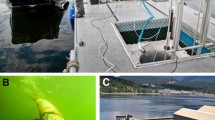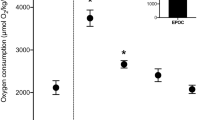Abstract
Diving birds can lose significant body heat to cold water, but costs can be reduced if heat from exercising muscles or the heat increment of feeding (HIF) can substitute for thermogenesis. Potential for substitution depends jointly on the rate of heat loss, the rate of heat produced by exercise, and the level of HIF. To explore these interactions, we measured oxygen consumption by lesser scaup ducks (Aythya affinis) diving to depths of 1.2 and 2 m at thermoneutral (23°C) and sub-thermoneutral (18 and 8°C) temperatures. Birds dove while fasted and when feeding on blue mussels (Mytilus edulis). Substitution occurred if HIF or costs of diving above resting metabolic rate (RMR) were lower at 18 or 8°C than at 23°C, indicating reduction in the thermoregulatory part of RMR. For fasted scaup diving to 1.2 m, substitution from exercise heat was not apparent at either 18 or 8°C. At 2 m depth, dive costs above RMR were reduced by 5% at 18°C and by 40% at 8°C, indicating substitution. At 1.2 m depth (with voluntary intake of only 14–17% of maintenance requirements), HIF did not differ between temperatures, indicating no substitution. However, at 2 m (intake 13–25% of maintenance), substitution from HIF was 23% of metabolizable energy intake at 18°C and 22% at 8°C. These results show that even with low HIF due to low intake rates, substitution from HIF can add to substitution from the heat of exercise.

Similar content being viewed by others
Abbreviations
- c :
-
Specific heat of tissue
- DRC:
-
Dive recovery cost
- GE:
-
Gross energy
- HIF:
-
Heat increment of feeding
- Mb :
-
Body mass
- ME:
-
Metabolizable energy
- MRdive :
-
Cost of diving while submerged
- MRtotal :
-
Total cost of dive
- RMR:
-
Resting metabolic rate
- RQ:
-
Respiratory quotient
- S h :
-
Heat storage in body
- T b :
-
Body core temperature
- \( \ifmmode\expandafter\dot\else\expandafter\.\fi{V} _{{{\text{O}}_{{\text{2}}} }}\) :
-
Rate of oxygen consumption
References
Banta MR, Lynott AJ, VanSant MJ, Bakken GS (2004) Partitioning heat loss from mallard ducklings swimming on the air–water interface. J Exp Biol 207:4551–4557
Bartholomew GA, Vleck D, Vleck CM (1981) Instantaneous measurements of oxygen consumption during pre-flight warm-up and post-flight cooling in sphingid and saturniid moths. J Exp Biol 90:17–32
Bech C, Præsting KE (2004) Thermoregulatory use of heat increment of feeding in the tawny owl (Strix aluco). J Therm Biol 29:649–654
Bevan RM, Butler PJ (1992a) The effects of temperature on the oxygen consumption, heart rate and deep body temperature during diving in the tufted duck Aythya fuligula. J Exp Biol 163:139–151
Bevan RM, Butler PJ (1992b) Cardiac output and blood flow distribution during swimming and voluntary diving of the tufted duck (Aythya fuligula). J Exp Biol 168:199–217
Bevan RM, Speakman JR, Butler PJ (1995) Daily energy expenditure in tufted ducks: a comparison between indirect calorimetry, doubly labelled water and heart rate. Funct Ecol 9:40–47
Blaxter KM (1989) Energy metabolism in animals and man. Cambridge University Press, Cambridge
Boutilier C, Bougues L, Timbal J (1977) Experimental study of convective heat transfer coefficient for the human body. J Appl Physiol Resp Environ Exerc Physiol 42:93–100
Bryant DM, Hails CJ, Prys-Jones R (1985) Energy expenditure by free-living dippers (Cinclus cinclus) in winter. Condor 87:177–186
Campbell KL, McIntyre IW, MacArthur RA (2000) Postprandial heat increment does not substitute for active thermogenesis in cold-challenged star-nosed moles (Condylura cristata). J Exp Biol 203:301–310
Chappell MA, Bachman GC, Hammond KA (1997) The heat increment of feeding in house wren chicks: magnitude, duration, and substitution for thermostatic costs. J Comp Physiol B 167:313–318
Costa DP, Kooyman GL (1984) Contribution of specific dynamic action to heat balance and thermoregulation in the sea otter Enhydra lutris. Physiol Zool 57:199–203
Custer CM, Custer TW, Sparks DW (1996) Radio telemetry documents 24-hour feeding activity of wintering lesser scaup. Wilson Bull 108:556–566
Dawson WR, Whittow GC (2000) Regulation of body temperature. In: Whittow GC (ed) Avian physiology, 5th edn. Springer, Berlin Heidelberg New York, pp 343–390
de Leeuw JJ (1996) Diving costs as a component of daily energy budgets of aquatic birds and mammals: generalizing the inclusion of dive recovery costs demonstrated in tufted ducks. Can J Zool 74:2131–2142
de Leeuw JJ, Butler PJ, Woakes AJ, Zegwaard F (1998) Body cooling and its energetic implications for feeding and diving in tufted ducks. Physiol Zool 71:720–730
de Vries J, van Eerden MR (1995) Thermal conductance in aquatic birds in relation to the degree of water contact, body mass, and body fat: energetic implications of living in a strong cooling environment. Physiol Zool 68:1143–1163
Fish FE (1983) Metabolic effects of swimming velocity and water temperature in the muskrat (Ondatra zibethicus). Comp Biochem Physiol 75A:397–400
Glahn JF, Brugger KE (1995) The impact of double-crested cormorants on the Mississippi Delta catfish industry: a bioenergetics model. Colon Waterbirds 18(Spec Publ 1):168–175
Grémillet D, Tuschy I, Kierspel M. (1998) Body temperature and insulation in diving great cormorants and European shags. Funct Ecol 12:386–394
Guthery FS, Lusk JJ, Peterson MJ (2001) The fall of the null hypothesis: liabilities and opportunities. J. Wildl Manage 65:379–384
Handrich Y, Bevan RM, Charrassin J-B, Butler PJ, Pütz K, Woakes AJ, Lage J, Le Maho Y (1997) Hypothermia in foraging king penguins. Nature 388:64–67
Hawkins PAJ, Butler PJ, Woakes AJ, Gabrielsen GW (1997) Heat increment of feeding in Brünnich’s guillemot Uria lomvia. J Exp Biol 200:1757–1763
Hindle AG, McIntyre IW, Campbell KW, MacArthur RA (2003) The heat increment of feeding and its thermoregulatory implications in the short-tailed shrew (Blarina brevicauda). Can J Zool 81:1445–1453
Hochachka PW (1988) Metabolic suppression and oxygen availability. Can J Zool 66:152–158
Hockey PAR (1984) Growth and energetics of the African black oystercatcher Haematopus moquini. Ardea 72:111–117
Jenssen BM, Ekker M, Bech C (1989) Thermoregulation in winter-acclimatized common eiders (Somateria mollissima) in air and water. Can J Zool 67:669–673
Jeske CW, Percival HF (1995) Time and energy budgets of wintering ring-necked ducks Aythya collaris in Florida, USA. Wildfowl 46:109–118
Johnson DH (1999) The insignificance of statistical significance testing. J Wildl Manage 63:763–772
Kaseloo PA, Lovvorn JR (2003) Heat increment of feeding and thermal substitution in mallard ducks feeding voluntarily on grain. J Comp Physiol B 173:207–213
Kaseloo PA, Lovvorn JR (2005) Effects of surface activity patterns and dive depth on thermal substitution in fasted and fed lesser scaup ducks (Aythya affinis). Can J Zool 83:301–311
Klaassen M, Bech C, Slagsvold G (1989) Basal metabolic rate and thermal conductance in arctic tern chicks and the effect of heat increment of feeding on thermoregulatory expenses. Ardea 77:193–200
Kooyman GL, Gentry RL, Begman WP, Hammel HT (1976) Heat loss in penguins during immersion and compression. Comp Biochem Physiol A 54:75–80
Lovvorn JR, Jones DR, Blake RW (1991) Mechanics of underwater locomotion in diving ducks: drag, buoyancy and acceleration in a size gradient of species. J Exp Biol 159:89–108
MacArthur RA, Campbell KL (1994) Heat increment of feeding and its thermoregulatory benefit in the muskrat (Ondatra zibethicus). J Comp Physiol B 164:141–146
Masman D, Daan S, Beldhuis HJA (1988) Ecological energetics of the kestrel: daily energy expenditure throughout the year based on time-energy budget, food intake and doubly labeled water methods. Ardea 76:64–81
McDonald P, Edwards RA, Greenhalgh JFD, Morgan CA (1995) Animal nutrition, 5th edn. Wiley, New York
Meienberger C, Dauberschmidt C (1992) Can the “specific dynamic action” (SDA) contribute to the thermoregulation of granivorous song birds [in German]? J Ornithol 133:33–41
Paladino FV, King JR (1984) Thermoregulation and oxygen consumption during terrestrial locomotion by white-crowned sparrows Zonotrichia leucophrys gambelli. Physiol Zool 57:226–236
Parkes R, Halsey LG, Woakes AJ, Holder RL, Butler PJ (2002) Oxygen uptake during post dive recovery in a diving bird Aythya fuligula: implications for optimal foraging models. J Exp Biol 205:3945–3954
Piersma T, Dekinga A, van Gils JA, Achterkamp B, Visser GH (2003) Cost-benefit analysis of mollusc eating in a shorebird. I. Foraging and processing costs estimated by the doubly labelled water method. J Exp Biol 206:3361–3368
Poehlman ET, Horton ES (1989) The impact of food intake and exercise on energy expenditure. Nutr Rev 47:129–137
Ponganis PJ, Van Dam RP, Knower T, Levenson DH (2001) Temperature regulation in emperor penguins foraging under sea ice. Comp Biochem Physiol A 129:811–820
Robbins CT (1993) Wildlife feeding and nutrition, 2nd edn. Academic, San Diego
Schreer JF, Kovacs KM (1997) Allometry of diving capacity in air-breathing vertebrates. Can J Zool 75:339–358
Stahel CD, Nicol SC (1982) Temperature regulation in the little penguin, Eudyptula minor, in air and water. J Comp Physiol 148:93–100
Stainsby WN, Gladden LB, Barclay JK, Wilson BA (1980) Exercise efficiency: validity of base-line subtractions. J Appl Physiol Resp Environ Exerc Physiol 48:518–522
Stephenson R, Jones DR (1992) Blood flow distribution in submerged and surface-swimming ducks. J Exp Biol 166:285–296
Vaillancourt E, Prud-Homme S, Haman F, Guglielmo CG, Weber J-M (2005) Energetics of a long-distance migrant shorebird (Philomachus pugnax) during cold exposure and running. J Exp Biol 208:317–325
Wacasey JW, Atkinson EG (1987) Energy values of marine benthic invertebrates from the Canadian Arctic. Mar Ecol Prog Ser 39:243–250
Weathers WW, Buttemer WA, Hayworth AM, Nagy KA (1984) An evaluation of time-budget estimates of daily energy expenditure in birds. Auk 101:459–472
Weathers WW, Sullivan KA (1993) Seasonal patterns of time and energy allocation by birds. Physiol Zool 66:511–536
Webster MD, Weathers WW (1990) Heat produced as a by-product of foraging activity contributes to thermoregulation by verdins, Auriparus flaviceps. Physiol Zool 63:777–794
Withers PC (1977) Measurement of VO2, VCO2 and evaporative water loss with a flow-through mask. J Appl Physiol 42:120–123
Zerba E, Walsberg GE (1992) Exercise-generated heat contributes to thermoregulation by Gambel’s quail in the cold. J Exp Biol 171:409–422
Zerba E, Dana AN, Lucia MA (1999) The influence of wind and locomotor activity on surface temperature and energy expenditure of eastern house finch (Carpodacus mexicanus) during cold stress. Physiol Zool 72:265–276
Acknowledgements
This work was supported by US National Science Foundation grants OPP-9813979 and ARC-0454454 to JRL, the University of Wyoming Office of Research, and assistantships from the University of Wyoming Department of Zoology. J.P. Bobbitt and staff of the Red Buttes Environmental Biology Laboratory provided much technical assistance. All experiments were conducted according to University of Wyoming guidelines for animal care.
Author information
Authors and Affiliations
Corresponding author
Additional information
Communicated by H.V. Carey
Rights and permissions
About this article
Cite this article
Kaseloo, P.A., Lovvorn, J.R. Substitution of heat from exercise and digestion by ducks diving for mussels at varying depths and temperatures. J Comp Physiol B 176, 265–275 (2006). https://doi.org/10.1007/s00360-005-0047-6
Received:
Revised:
Accepted:
Published:
Issue Date:
DOI: https://doi.org/10.1007/s00360-005-0047-6




